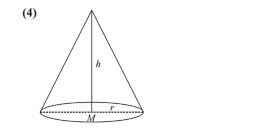The maximum volume (in cu.m) of the right circular cone having slant height $3 \mathrm{~m}$ is:
Correct Option: , 4

$h^{2}+r^{2}=\ell^{2}=9$ ........(1)
Volume of cone
$V=\frac{1}{3} \pi r^{2} h$ ..........(2)
From (1) and (2),
$\Rightarrow \quad V=\frac{1}{3} \pi\left(9-h^{2}\right) h$
$\Rightarrow \quad V=\frac{1}{3} \pi\left(9 h-h^{3}\right)$ $\Rightarrow \frac{d v}{d h}=\frac{1}{3} \pi\left(9-3 h^{2}\right)$
For maxima/minima,
$\frac{d V}{d h}=0 \Rightarrow \frac{1}{3} \pi\left(9-3 h^{2}\right)=0$
$\Rightarrow h=\pm \sqrt{3} \Rightarrow h=\sqrt{3}$ $(\because h>0)$
Now; $\frac{d^{2} V}{d h^{2}}=\frac{1}{3} \pi(-6 h)$
Here, $\left(\frac{d^{2} V}{d h^{2}}\right)_{\text {at } h=\sqrt{3}}<0$
Then, $h=\sqrt{3}$ is point of maxima
Hence, the required maximum volume is,
$V=\frac{1}{3} \pi(9-3) \sqrt{3}=2 \sqrt{3} \pi$
Click here to get exam-ready with eSaral
For making your preparation journey smoother of JEE, NEET and Class 8 to 10, grab our app now.
